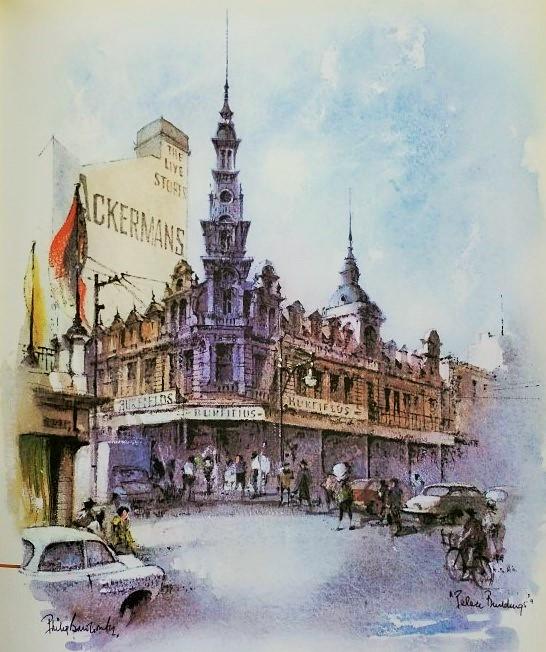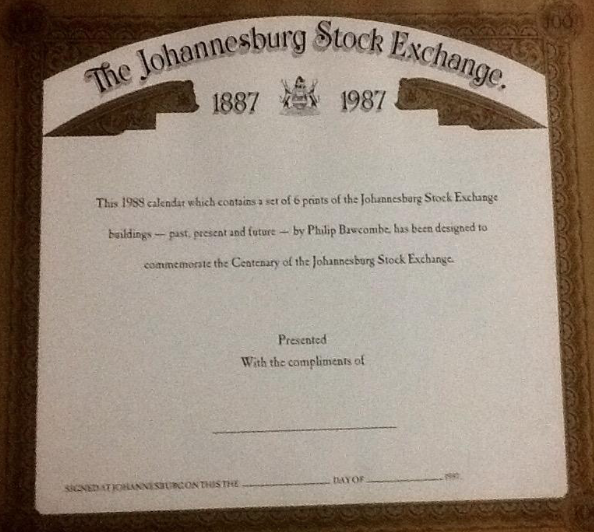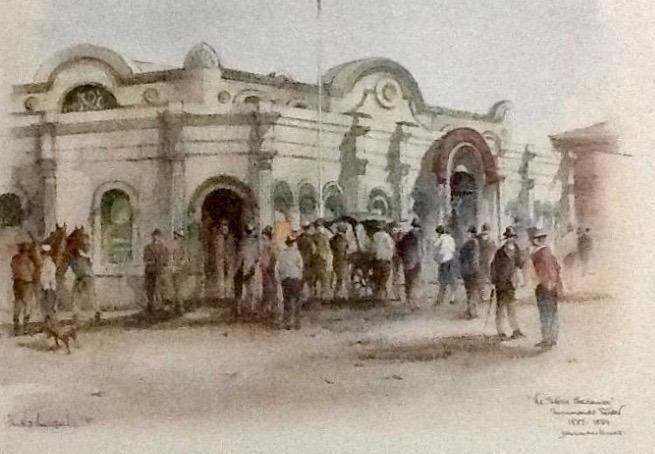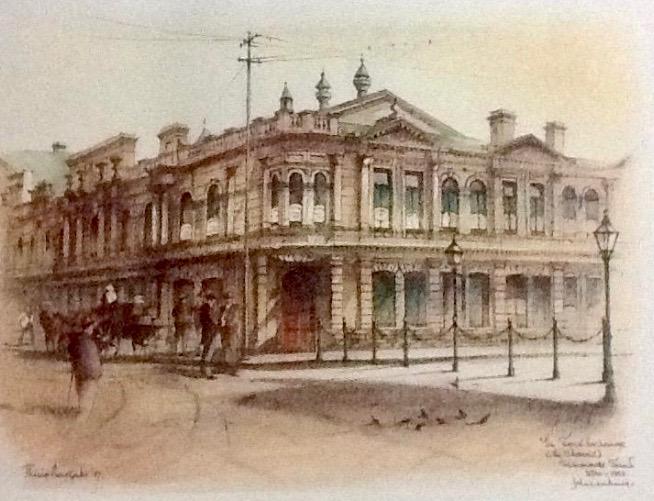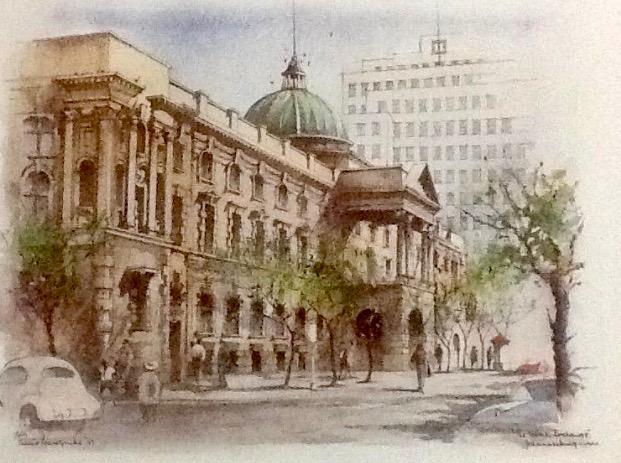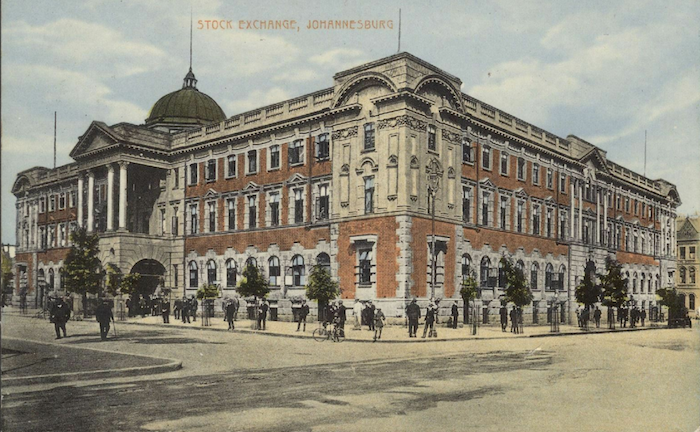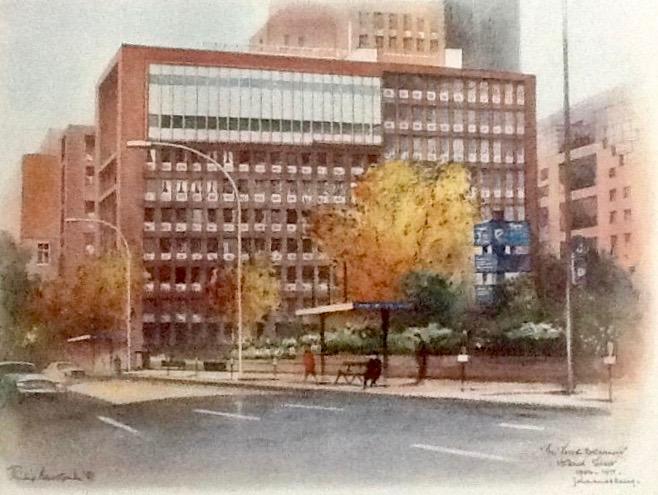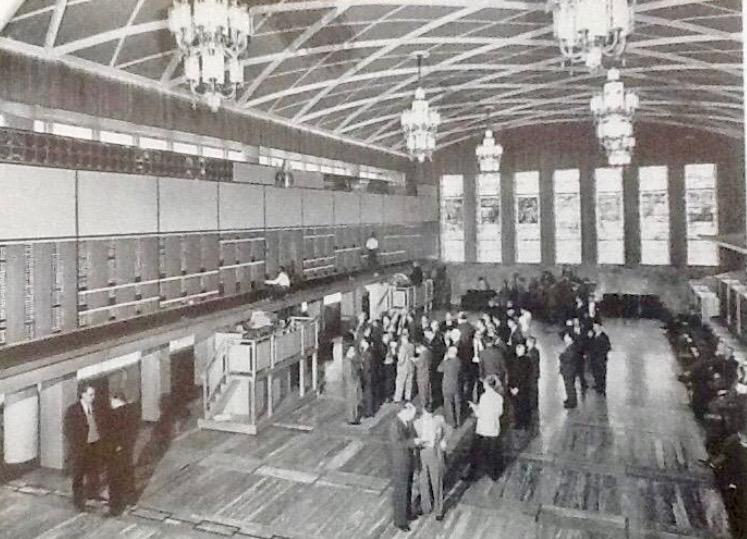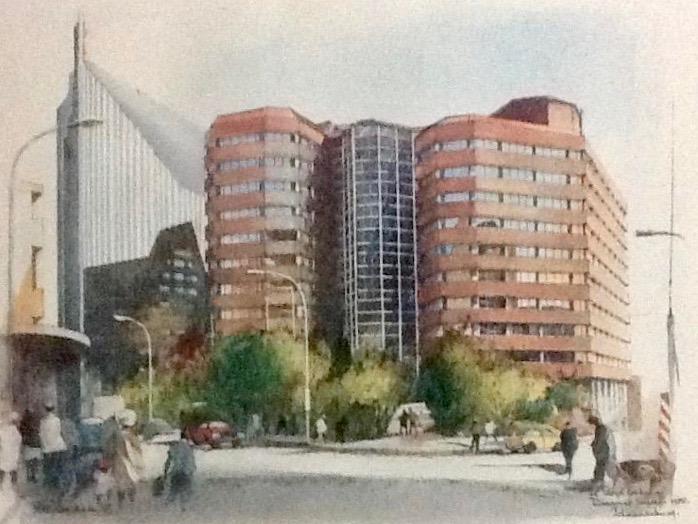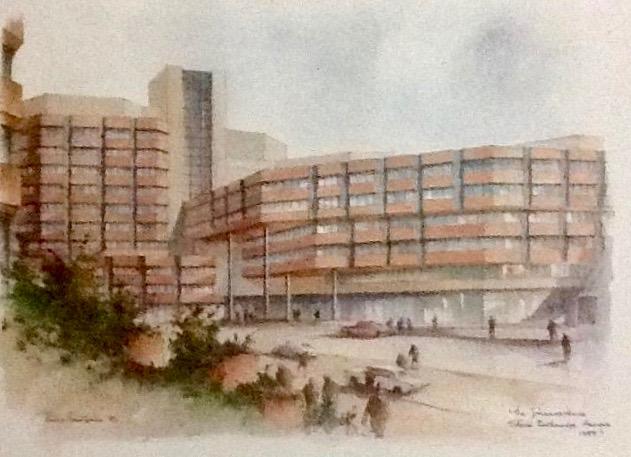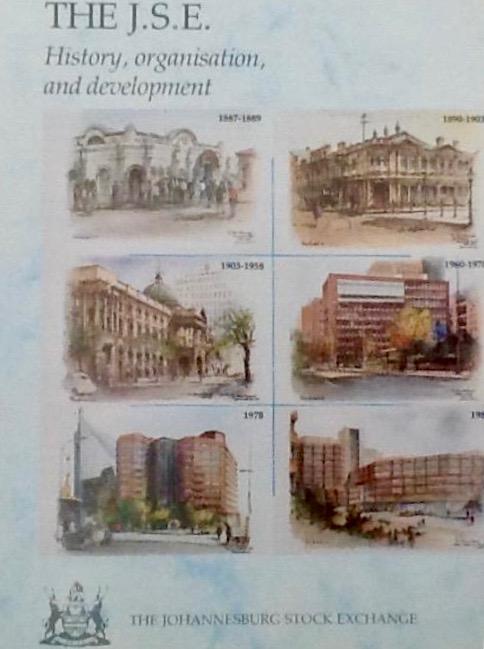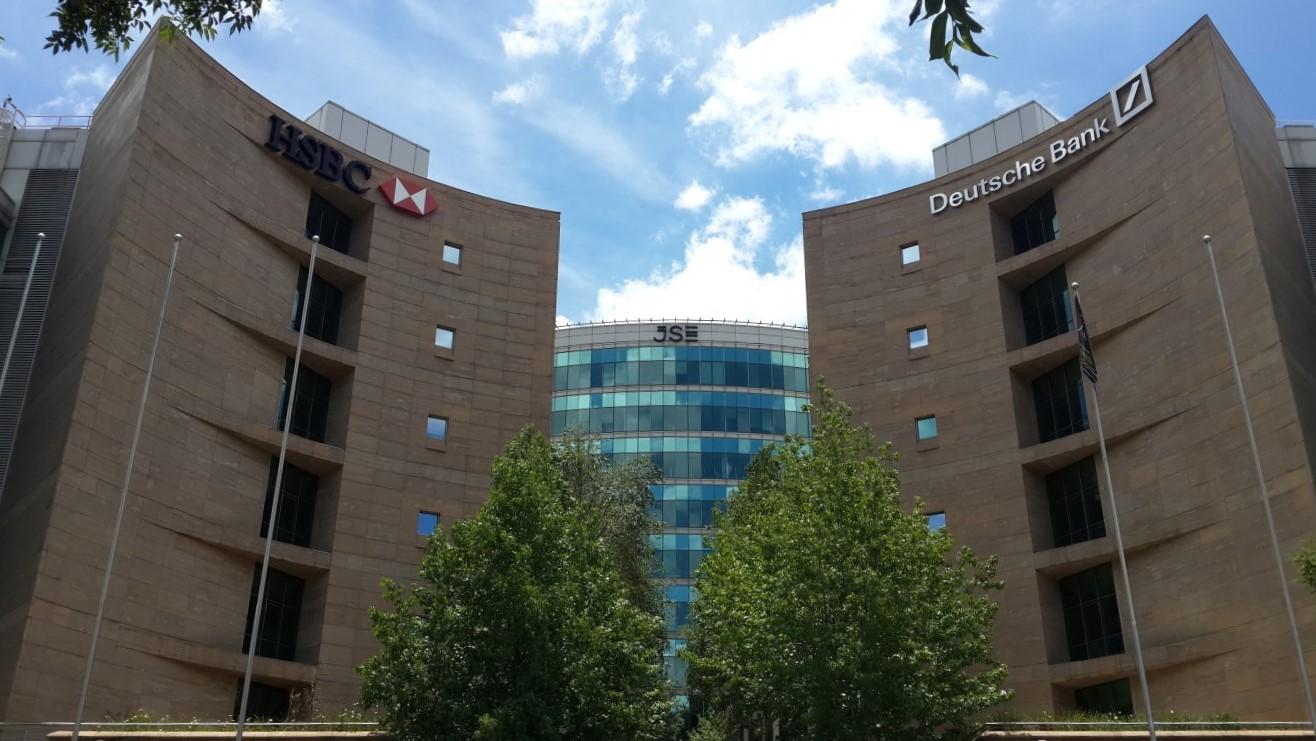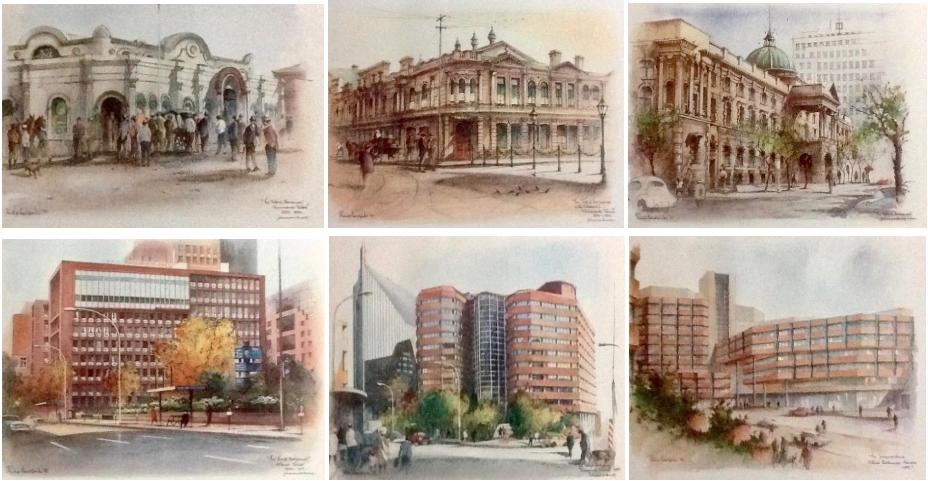
Disclaimer: Any views expressed by individuals and organisations are their own and do not in any way represent the views of The Heritage Portal. If you find any mistakes or historical inaccuracies, please contact the editor.
The Johannesburg Heritage Foundation has been given the generous gift of a delightful 1987 centenary calendar, celebrating the 100 years of the Johannesburg Stock Exchange. The Calendar comprises six prints of watercolours by the well-known artist of that era, Philip Bawcombe.
We have taken the decision to photograph the prints and share them with the heritage community but also to sell the Calendar as a fundraiser for the JHF. The price we are asking is R600 for 6 large prints – the size is 52 x 49 cms for each print on high quality paper. They are eminently suitable for framing as a set of 6 and ideal for a company office or a study. You will be supporting a good cause as the JHF will use these funds for its work (e.g. the digitization of heritage records, more blue plaques for Johannesburg, the restoration of stained glass windows in a heritage church, supporting the Johannesburg Zoo 115 celebration etc.). We are always in need of donations to spend on heritage projects. Email - Katherine.Munro@wits.ac.za.
Thank you to Tom Bramwell for his donation and James Findlay for his ongoing support.
Philip Bawcombe watercolour prints are very collectable. He was best known for his delightful books Bawcombe’s Johannesburg (1973) and Bawcombe’s Kimberley (1976). The text in both books was by Ted Scannell. H.F. Oppenheimer hailed Philip Bawcombe’s Kimberley (1976) as capturing “the spirit and portraying the fabric of old Kimberley,” and announced that his De Beers Company had acquired the original collection for permanent display.
Palace Building by Philip Bawcombe
These Johannesburg Stock Exchange historic prints were prepared specially for the Stock Exchange centenary.
Philip Bawcombe (born in London 1906 and died in South Africa in 2000) was a watercolour artist and an industrial artist. He was a Fellow of the Royal Society of Arts (1938). He started life as an industrial designer and shop fitter. From 1930 Bawcombe applied his skills to film sets joining the industrial art department of Gaumont-British Picture Corporation and in 1932 he joined the nascent Sound Film Producing & Recording Studios, which later became Shepperton Studios, as resident art director. During World War II, 1939-43 Bawcombe worked in a Camouflage unit in the Middle East (the objective was to make the Allied military appear more impressive and substantial through illusion and art). Between 1943 and 1945 he was an official South African war artist and a body of his work from that period is to be found in the Ditsong Military History Museum in Johannesburg. In 1953 Bawcombe was the official designer of the Rhodes centenary exhibition in Bulawayo. He participated in many group exhibitions between 1944 and 1970 in South Africa, Mozambique and Swaziland. Following the publication of his two books on Johannesburg and Kimberley, Bawcombe’s watercolours also became popular for commissioned prestige calendars for banks and building societies. Bawcombe featured in the July 1978 issue of the Lantern. I own another series of Bawcombe Calendar prints of his watercolours for Pilgrim’s Rest.
James Ball wrote an article on Johannesburg Stock Exchange buildings through the decades (click here to view) and I have used that article to provide the outline information on each of the buildings below. The Bawcombe prints add to the historical record of the Stock Exchange. Of course the most recent of the Stock Exchange buildings is at Exchange Square in Sandton and Bawcombe’s Calendar predated that last sixth Stock Exchange building. In fact in 1987 the newest Stock exchange (the fifth) being celebrated by Bawcombe was on Diagonal Street.
Calendar Cover
The First Stock Exchange in Johannesburg 1887-1889
The First Stock Exchange Building was completed in 1887, a year after the founding of Johannesburg. Benjamin Woollan was the man who launched the Stock Exchange. It was located on the corner of Simmonds and Commissioner Streets, a site later occupied by the S A Permanent building society (Rosenthal, p 142). The capital for the new enterprise was £5000; it was immediately subscribed and Woollan was the first chairman. The official birthday was 8th November 1887, but work had commenced on the building in the second half of 1887; it was a single storey building with several entrances and a long row of windows. The building comprised a central hall 50 x 25 feet and 30 feet high, with circular instead of pointed gables and small oriel windows in each gable. Van der Waal states that the architect was Fred Holman. But Rosenthal states that the plans appear to have been provided by Mr Lindhorst, the government architect (who had designed the gaol, early government buildings and a number of early shops).
This first stock exchange was very short lived and was demolished in 1889. The Star described it as” perhaps the most hideous building that the fancy of man has ever imagined. For years it has been an eyesore to the nascent beauties of the town.“ (quoted by Rosenthal, p 144).
The overflow trading activity happened in the open in Simmonds Street and as the street was closed off by bollards and chains, so the expression “between the chains“ emerged as a unique Johannesburg phrase.
Of course the very location of the Johannesburg Stock Exchange: Simmonds Street, Hollard Street, Diagonal Street and now Exchange Square / Maude Street is synonymous with high finance and the market place for shares and stocks and raising capital for the South African economy.
Bawcombe's drawing of the First Johannesburg Stock Exchange
The Stock Exchange (the Chains) Simmonds Street, 1890-1902.
"The Second Stock Exchange Building replaced the first within two years reflecting the rapid growth of the young mining town. The foundation stone was laid in November 1889 and the building was completed in 1890. It was designed by the firm Lennox Canning & Goad and had an impressive facade and large trading hall. Tough economic conditions hit Johannesburg in the early 1890s resulting in the eastern portion of the building only being completed in 1893. This section was designed by AH Reid.” (James Ball, The Heritage Portal)
This second exchange was a double storey building; it stood on the same site as the first stock exchange. It survived until 1903 and it was at that date that the Stock Exchange moved to Hollard Street.
Bawcombe's drawing of the Second Johannesburg Stock Exchange
The Third Stock Exchange Building
Bawcombe's label (Johannesburg circa 1960) is an error as by the date 1960 this third stock exchange had been demolished. “The Third Stock Exchange was completed in 1904 on a new site in Hollard Street. Once again the need for greater space and more modern features was the catalyst for the move. The building was designed by the famous firm Leck & Emley and included 210 offices and a two storey 28.3m by 22m main hall. The move sparked the shift of the financial district westwards with Hollard Street becoming ‘The Wall Street of Johannesburg' for over seven decades before the JSE moved on again. The Third Stock Exchange was demolished in 1958 to make way for a new exchange on the same site.” (James Ball, The Heritage Portal).
The Third Stock Exchange in Johannesburg lasted from 1904 to 1957. It served for 54 years. Rosenthal describes it as a building that was unmatched on the Rand in size and magnificence, rivalled only by the Corner House. Built in Transvaal stone at a total cost of 160 000, its style paid homage to the London buildings of Inigo Jones and Christopher Wren’s Whitehall buildings. The 1905 Dennis Edwards guide described the Exchange Hall as 90 feet long and 70 feet wide, divided by arcades of marble column into a nave and two aisles. A gallery for the use of visitors ran along one end.
Bawcombe's drawing of the Third Johannesburg Stock Exchange
Old postcard of the Third Stock Exchange
The Stock Exchange, Hollard Street 1959-1977, Johannesburg (Bawcombe’s label)
After the post Second World War expansion and development of the Free State gold mines as well as the West Wits and Klerksdorp areas, the Third Johannesburg Stock Exchange had been outgrown by the economy. The market value of securities traded on the Johannesburg stock exchange was 4.5 billion. Dozens of brokers found offices in other buildings. A new Stock exchange was proposed as early as 1948 but it was not until 1956 that plans for a new building were firmed up. Gordon Summerley of the firm of Nurcombe, Summerley, Ringrose and Todd was the lead architect who travelled abroad to synthesise ideas. The location remained Hollard Street (or as it was called Hollard Gardens) and the new building met the needs of both the Stock Exchange and the insurance company Eagle Star. Hence the building took the form of two sky scrapers for the JSE and Eagle Star House. The third stock exchange was demolished and the new fourth stock exchange rose in its place between 1957-8 and 1961. Trading took place here from November 1960 to December 1976. When this building ceased to be the home of the JSE, it was converted into the Hollard Street Squash Club with Peter Rich being the architect. The building has been awarded a C grade by the JHF. A distinctive feature of the Hollard Street era was the conversion of Hollard Street into a pedestrianised area and garden with a number of significant public sculptures such as the Bull and Bear work by Eduardo Villa.
“The Fourth Stock Exchange Building emerged from the rubble of the Third and was completed in 1961. A powerful public relations exercise led to Presidents and Chairmen of famous stock exchanges including London, New York, Paris and Frankfurt being invited to the grand opening. The new building included a majestic trading floor located on the seventh floor (rising to the ninth), an exhibition hall, a committee dining room, a cinema projection room and plenty of office space. The JSE would call this building home for a brief 17 years” (James Ball, The Heritage Portal)
Bawcombe's drawing of the Fourth Johannesburg Stock Exchange
Trading Hall of the Fourth Johannesburg Stock Exchange Building (Architectural Record 1961)
The Stock Exchange Diagonal Street, 1978
"The Fifth Stock Exchange Building, located at 17 Diagonal Street, opened in 1979 and marked the end of the Hollard Street era. It was designed by Monty Sack and was one of the first atrium buildings in Johannesburg. Commentators at the time believed that the move would be a major catalyst for the development of the area from Diagonal Street westwards to the M1. Although a number of significant buildings were erected, the overall vision for the area fell victim to the larger trend of CBD decline and the flight to the North. Predictions were made in 1979 that the JSE would be based at Diagonal Street for 50-75 years. It lasted just over twenty before relocating to Sandton. The old trading hall has been preserved and from time to time special functions are held there." (James Ball, The Heritage Portal)
Bawcombe's drawing of the Fifth Johannesburg Stock Exchange Building
The Johannesburg Stock Exchange Annexe 1988 17 Diagonal Street
In Bawcombe’s time this was the newest 1980s addition to the stock exchange with an annexe added in 1988. “In 2000 the Johannesburg Stock Exchange relocated from 17 Diagonal Street to its current home at Exchange Square on Gwen Lane / Maude Street in Sandton. Exchange Square was designed by TPC architects and is surrounded by banks, hotels and corporate headquarters." (James Ball, The Heritage Portal)
Bawcombe's drawing of the JSE Annexe
The Bawcombe images were used in a publicity pamphlet for 1987 promoting the JSE and explaining its operation.
Publicity pamphlet
Bawcombe’s work has now become a collectable period piece. Bawcombe died before the move to the current Stock Exchange in Sandton on Gwen Lane / Maude Street. The best source of reference to date for this newest building is Julia Boltt (Editor) Exchange Square A landmark development - published in 2002.
Exchange Square Sandton (The Heritage Portal)
Kathy Munro is an Honorary Associate Professor in the School of Architecture and Planning at the University of the Witwatersrand. She enjoyed a long career as an academic and in management at Wits University. She trained as an economic historian. She is an enthusiastic book person and has built her own somewhat eclectic book collection over 40 years. Her interests cover Africana, Johannesburg history, history, art history, travel, business and banking histories. She researches and writes on historical architecture and heritage matters. She is a member of the Board of the Johannesburg Heritage Foundation and is a docent at the Wits Arts Museum. She is currently working on a couple of projects on Johannesburg architects and is researching South African architects, war cemeteries and memorials. Kathy is a member of the online book community the Library thing and recommends this cataloging website and worldwide network as a book lover's haven.
References
- Boltt, Julia (editor) (2002): Exchange Square A landmark development, Primedia publishing
- Bryant, M. (1987), Taking Stock: Johannesburg Stock Exchange, the first 100 years. Johannesburg Stock Exchange.
- Chipkin, C. M. (2008). Johannesburg Transition. Johannesburg. STE Publishers
- Chipkin, C. M. (1993). Johannesburg Style. Cape Town. David Philip Publishers
- Norwich, O. I. (1986). A Johannesburg Album. Johannesburg. AD. Donker
- Ogilvie, Grania ( 1988). The Dictionary of South African Painters and Sculptors , Everard Read- entry for Philip Bawcombe p 50-51
- Rosenthal, Eric, (1968). On Change through the Years A History of Share Dealing in South Africa, Flesch Financial Publications.
- Shorten, J. (1970). The Johannesburg Saga. Johannesburg. Cape and Transvaal Printers Limited
- South African Panorama, February 1961
- South African Architectural Record February 1961 – article on the 4th Stock Exchange.
- Stark, F. (1956). Seventy Golden Years. Johannesburg. Felix Stark
Comments will load below. If for any reason none appear click here for some troubleshooting tips. If you would like to post a comment and need instructions click here.

